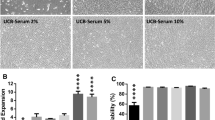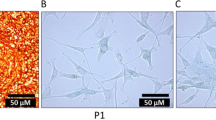Abstract
Recent findings have demonstrated umbilical cord, previously considered as a biomedical waste, as a source of stem cells with promising therapeutic applications in human as well as livestock species. The present study was carried out to isolate the umbilical cord matrix cells and culture for a prolonged period, cryopreserve these cells and test their post-thaw viability, characterize these cells for expression of stem cell markers and differentiation potential in vitro. The intact umbilical cord was taken out of the amniotic sac of a fetus and then incised longitudinally to remove umbilical vessels. Wharton’s jelly containing tissue was diced into small pieces and placed in tiny drops of re-calcified buffalo plasma for establishing their primary culture. Confluent primary culture was trypsinized and passaged with a split ratio of 1:2 for multiplication of cells. Cryopreservation of cells was performed at three different passages in cryopreservation medium containing 15%, 20% and 25% fetal bovine serum (FBS). A significant increase in post-thaw viability was observed in cells cryopreserved in freezing medium with higher concentration of FBS. After re-culturing, frozen-thawed cells started adhering, and spike formation occurred within 4–6 h with similar morphology to their parent representative cultures. The normal karyotype and positive expression of alkaline phosphatase and pluripotency genes OCT4, NANOG and SOX2 were observed at different passages of culture. When induced, these cells differentiated into adipogenic and osteogenic cells as confirmed by oil red O and alizarin red stains, respectively. This study indicates that buffalo umbilical cord matrix cells have stemness properties with mesenchymal lineage restricted differentiation and limited proliferation potential in vitro.



Similar content being viewed by others
References
Abdulrazzak H.; Moschidou D.; Jones G.; Guillot P. V. Biological characteristics of stem cells from foetal, cord blood and extraembryonic tissues. J. R. Soc. Interface 6: 689–706; 2010.
Azari O.; Babaei H.; Derakhshanfar A.; Nematollahi-Mahani S. N.; Poursahebi R.; Moshrefi M. Effect of transplanted mesenchymal stem cells isolated from Wharton’s jelly of caprine umbilical cord on cutaneous wound healing: histopathological evaluation. Vet. Res. Commun. 35: 211–222; 2011.
Baksh D.; Yao R.; Tuan R. S. Comparison of proliferative and multilineage differentiation potential of human mesenchymal stem cells derived from umbilical cord and bone marrow. Stem Cells 25: 1384–1392; 2007.
Bossolasco P.; Montemuroo T.; Cova L.; Zangrossi S.; Calzarossa C.; Buiatiotis S.; Soligo D.; Bosari S.; Silani V.; Delielers G. L.; Rebulla P.; Lazzari L. Molecular and phenotype characterization of human amniotic fluid cells and their differentiation potential. Cell Res. 16: 329–336; 2006.
Campagnoli C.; Roberts I. A. G.; Kumar S.; Bennett P. R.; Bellantuono I.; Fisk N. M. Identification of mesenchymal stem/progenitor cells in human first-trimester fetal blood, liver and bone marrow. Blood 98: 2396–2402; 2001.
Carlin R.; Davis D.; Weiss M.; Schultz B.; Troyer D. Expression of early transcription factors Oct4, Sox2 and Nanog by porcine umbilical cord (PUC) matrix cells. Reprod. Biol. Endocrinol. 4: 8–21; 2006.
Cremonesi F.; Corradetti B.; Consiglio A. L. Fetal adnexa derived stem cells from domestic animal: progress and perspectives. Theriogenology 75: 1400–1415; 2011.
Cremonesi F.; Violini S.; Lange Consiglio A.; Ramelli P.; Ranzenig G.; Mariani P. Isolation, in vitro culture and characterization of foal umbilical cord stem cells at birth. Vet. Res. Commun. 32: 139–142; 2008.
Hoynowski S. M.; Fry M. M.; Gardner B. M.; Leming M. T.; Tucker J. R.; Black L.; Sand T.; Mitchell K. E. Characterization and differentiation of equine umbilical cord derived matrix cells. Biochem. Biophys. Res. Commun. 362: 347–353; 2007.
In’t Anker P. S.; Scherjon S. A.; Kleijburg-van der Keur C.; de Groot-Swings G. M.; Claas F. H.; Fibbe W. E.; Kanhai H. H. H. Isolation of mesenchymal stem cells of fetal or maternal origin from human placenta. Stem Cells 22: 1338–1345; 2004.
In’t Anker P. S.; Scherjon S. A.; Kleijburg-van der Keur C.; Noort W. A.; Claas F. H. J.; Willemze R.; Fibbe W. E.; Kanhai H. H. H. Amniotic fluid as a novel source of mesenchymal stem cells for therapeutic transplantation. Blood 102: 1548–1549; 2003.
Karahuseyinoglu S.; Cinar O.; Kilic E.; Kara F.; Akay G. G.; Demiralp D. O.; Tukun A.; Uckan D.; Can A. Biology of stem cells in human umbilical cord stroma: in situ and in vitro surveys. Stem Cells 25: 319–331; 2007.
Kobayashi K.; Kubota T.; Aso T. Study on myofibroblast differentiation in the stromal cells of Wharton’s jelly: expression and localization of alpha-smooth muscle actin. Early Hum. Dev. 51: 223–233; 1998.
Lu L. L.; Liu Y. J.; Yang S. G.; Zhao Q. J.; Wang X.; Gong W.; Han Z. B.; Xu Z. C.; Lu Y. X.; Liu D.; Chen Z. Z.; Han Z. C. Isolation and characterization of human umbilical cord mesenchymal stem cells with hematopoiesis-supportive function and other potentials. Haematologica 91: 1017–1026; 2006.
Lund R. D.; Wang S.; Lu B.; Girman S.; Holmes T.; Sauv Y.; Messina D. J.; Harris I. R.; Kihm A. J.; Harmon A. M.; Chin F. Y.; Gosiewska A.; Mistry S. K. Cells isolated from umbilical cord tissue rescue photoreceptors and visual functions in a rodent model of retinal disease. Stem Cells 25: 602–611; 2007.
MacGregor G. R.; Zambrowicz B. P.; Soriano P. Tissue non-specific alkaline phosphatase is expressed in both embryonic and extraembryonic lineages during mouse embryogenesis but is not required for migration of primordial germ cells. Development 121(5): 1487–1496; 1995.
Majno G.; Gabbiani G.; Hirschel B. J.; Ryan G. B.; Statkov P. R. Contraction of granulation tissue in vitro: similarity to smooth muscle. Science 173: 548–550; 1971.
Mann A.; Yadav R. P.; Singh J.; Kumar D.; Singh B.; Yadav P. S. Culture, characterization and differentiation of cells from buffalo (Bubalus bubalis) amnion. Cytotechnology; 2012. doi:10.1007/s10616-012-9464-z.
Meyer F. A.; Laver-Rudich Z.; Tanenbaum R. Evidence for a mechanical coupling of glycoprotein microfibrils with collagen fibrils in Wharton’s jelly. Biochem. Biophys. Acta. 755: 376–387; 1983.
Miki T.; Lehmann T.; Cai H.; Stolz D.; Strom S. Stem cell characteristics of amniotic epithelial cells. Stem Cells 23: 1549–1559; 2005.
Moshrefi M.; Babaei H.; Nematollahi-Mahani S. N. Isolation and characterization of mesenchymal cells isolated from caprine umbilical cord matrix. Anim. Reprod. 7(4): 367–372; 2010.
Niwa H. How is the pluripotency determined and maintained. Development 134: 635–646; 2007.
Pappa K.; Anagnou N. Novel sources of fetal stem cells: where do they fit on the developmental continuum? Regen. Med. 4: 423–433; 2009.
Parry E. W. Some electron microscope observations on the mesenchymal structures of full term umbilical cord. J. Anatom. 107: 505–518; 1970.
Sarugaser R.; Lickorish D.; Baksh D.; Hosseini M. M.; Davies J. E. Human umbilical cord perivascular (HUCPV) cells: a source of mesenchymal progenitors. Stem Cells 23: 220–229; 2005.
Secco M.; Zucconi E.; Viera N. M.; Fogacca L. L. Q.; Cerqueira A.; Carvalho M. D. F.; Jazedje T.; Okamato O. K.; Muotri A. R.; Zatz M. Multipotent stem cells from umbilical cord: cord is richer than blood. Stem Cells 26(1): 146–150; 2008.
Soliman M. K. Studies on physiological chemistry of allantoic fluid of buffalo at various periods of pregnancy. Ind. Vet. J. 52: 106–112; 1975.
Violini S.; Ramelli P.; Pisani L. F.; Gorni C.; Mariani P. Horse bone marrow mesenchymal stem cells express embryo stem cell markers and show the ability for tenogenic differentiation by in vitro exposure to BMP-12. BMC Cell Biol. 10: 29; 2009. doi:10.1186/1471-2121-10-29.
Weiss M. L.; Medicity S.; Bledshoe A. R.; Rachakatla R. S.; Choi M.; Merchav S.; Luo Y.; Rao M. S.; Velagaleti G.; Troyer D. Human umbilical cord matrix stem cells: preliminary characterization and effect of transplantation in a rodent model of Parkinson’s disease. Stem Cells 24: 781–792; 2006.
Yadav P. S.; Mann A.; Singh J.; Kumar D.; Sharma R. K.; Singh I. Buffalo (Bubalus bubalis) fetal skin derived fibroblast cells exhibit characteristics of stem cells. Agric. Res. 1(2): 175–182; 2012a.
Yadav P. S.; Mann A.; Singh V.; Yashveer S.; Sharma R. K.; Singh I. Expression of pluripotency genes in buffalo (Bubalus bubalis) amniotic fluid cells. Reprod. Dom. Anim. 46(4): 705–711; 2011.
Yadav P. S.; Singh R. K.; Singh B. Fetal stem cells in farm animals: applications in health and production. Agric. Res. 1: 67–77; 2012b.
Acknowledgment
The authors wish to acknowledge Department of Biotechnology, Government of India, for financial support.
Author information
Authors and Affiliations
Corresponding author
Additional information
Editor: T. Okamoto
Rights and permissions
About this article
Cite this article
Singh, J., Mann, A., Kumar, D. et al. Cultured buffalo umbilical cord matrix cells exhibit characteristics of multipotent mesenchymal stem cells. In Vitro Cell.Dev.Biol.-Animal 49, 408–416 (2013). https://doi.org/10.1007/s11626-013-9617-1
Received:
Accepted:
Published:
Issue Date:
DOI: https://doi.org/10.1007/s11626-013-9617-1




